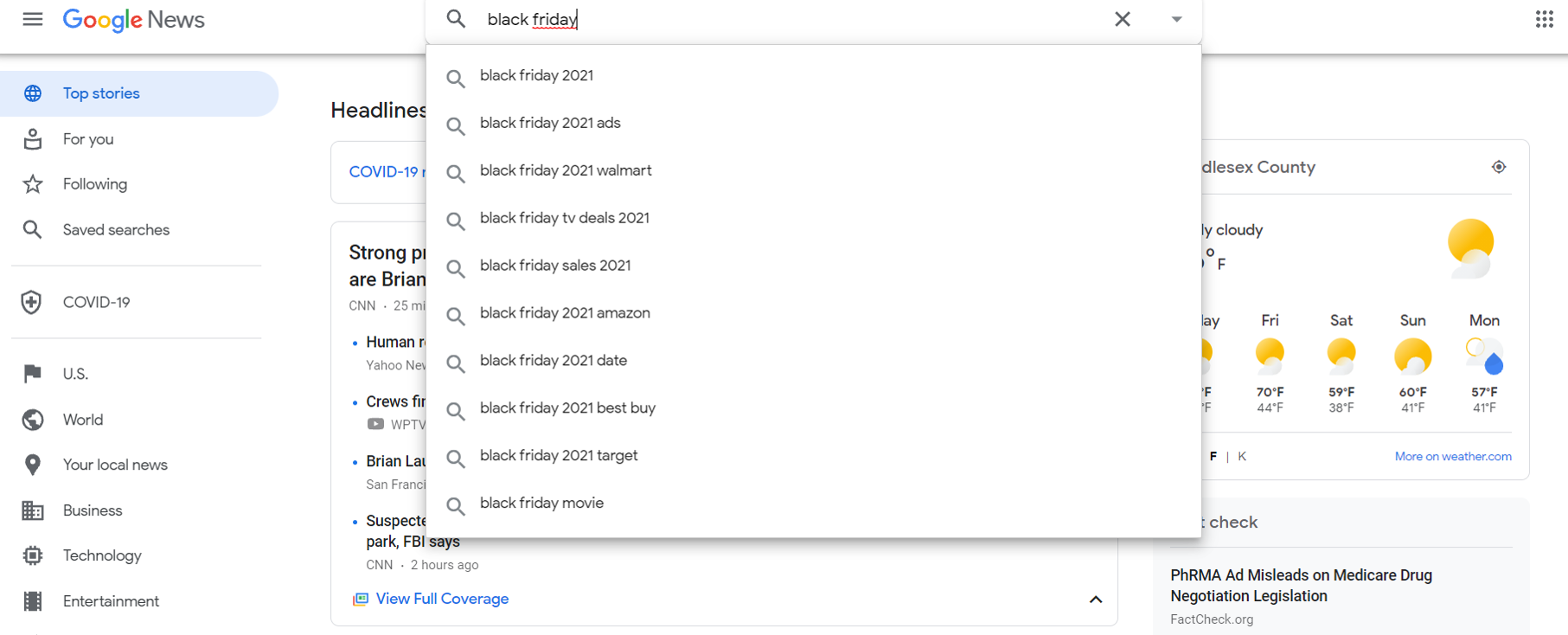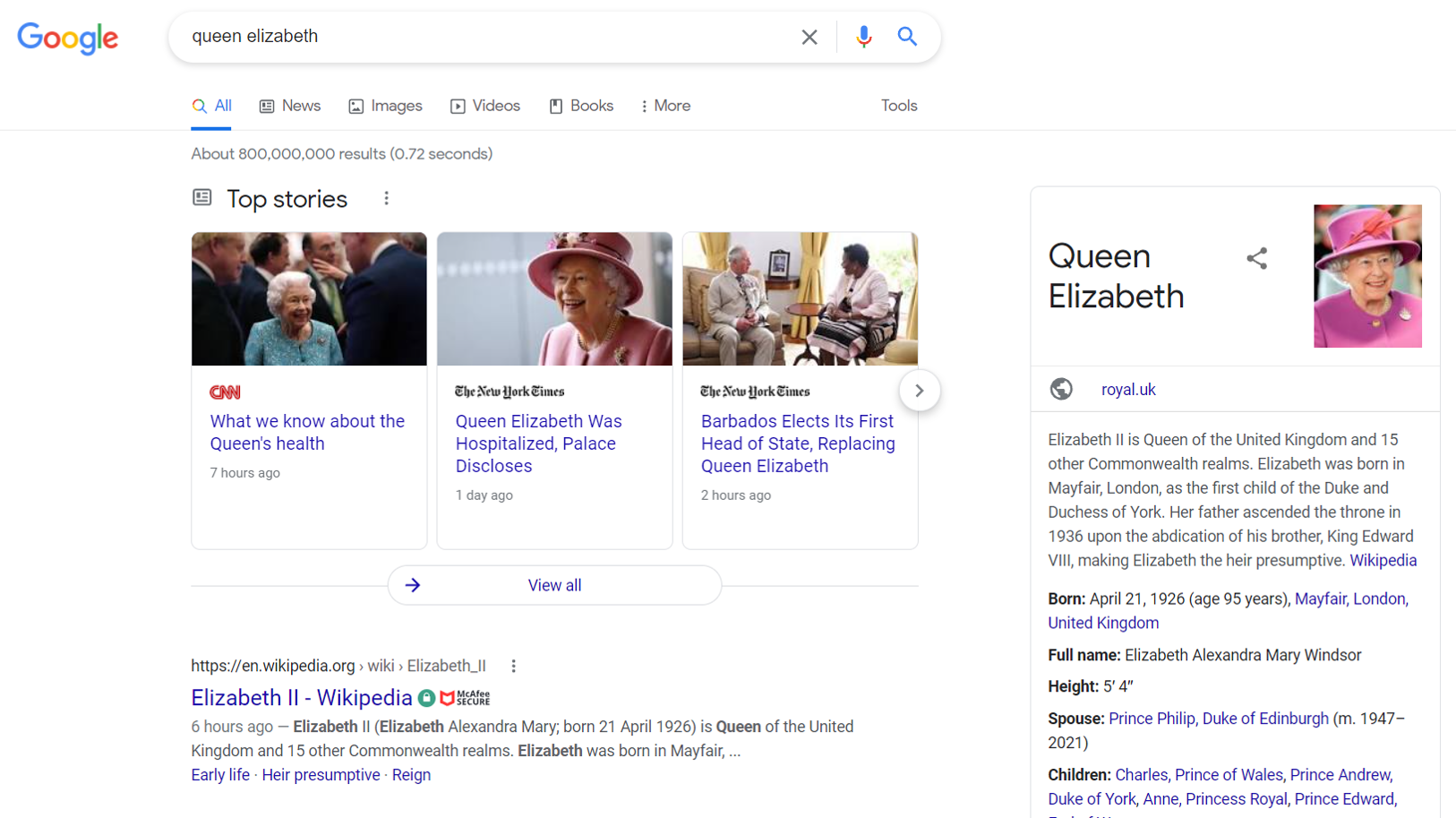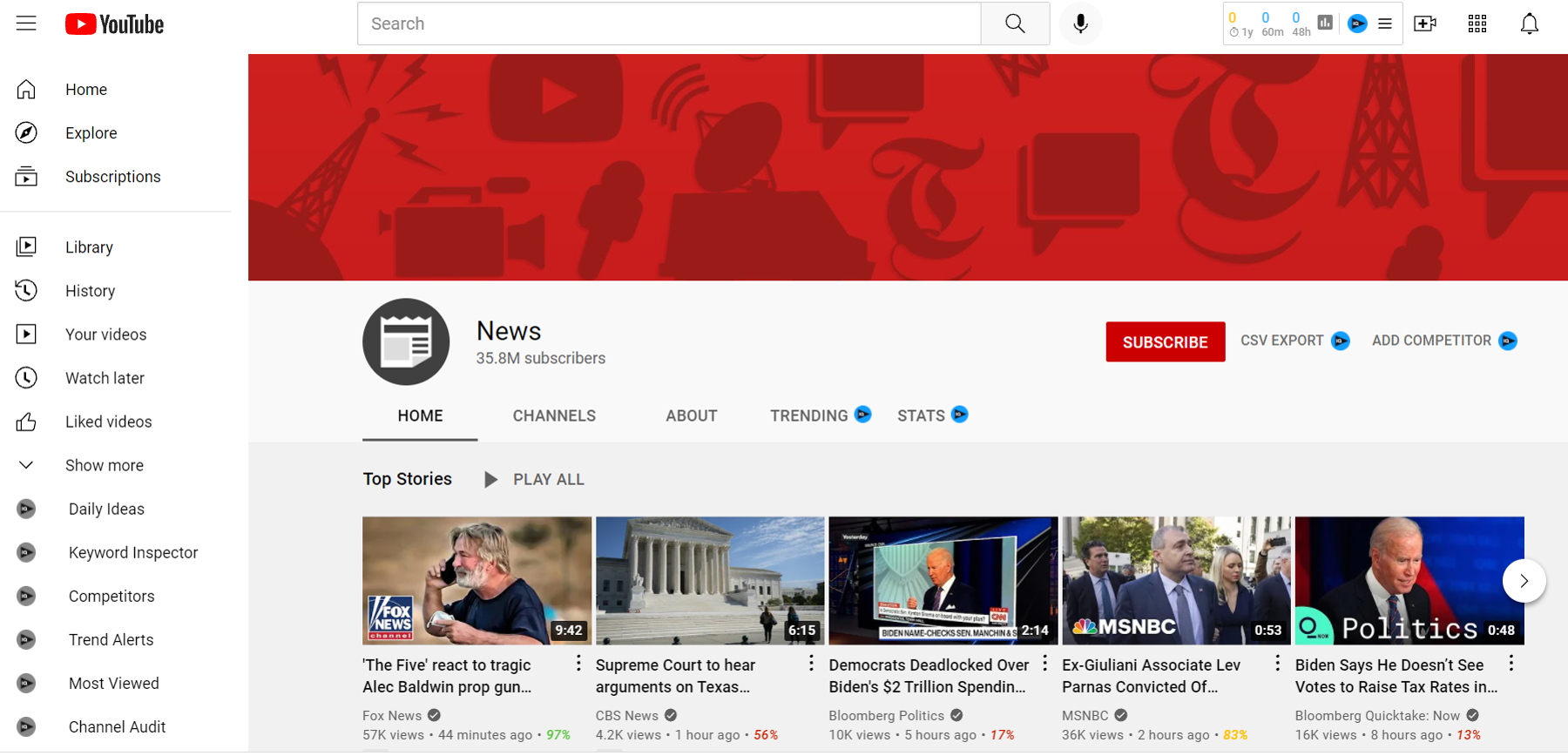Since the beta version of Google News was first launched back in September 2002, the news search engine has changed dramatically.
And over the years, many best practices of what is now called News SEO have changed, too.
The key to boosting your news site’s visibility and traffic today is figuring out what’s really new under the sun and what’s as old as great journalism itself.
For example, news content now appears on several different Google products including Google News, Google Search, YouTube, Google Assistant, and Discover.
That’s why Google provides three distinct but interconnected ways to discover news across their products and devices:
- Top News, with features like Headlines in Google News or Breaking News on YouTube. These showcase the important stories being covered at a given point in time and are not personalized.
- Personalized News, with products like Discover, features like the “For You” section in Google News, or the “Latest” tab of the YouTube app on TVs, help individual users stay informed about subjects that matter most to them.
- Deep context and diverse perspectives, within features like Top Stories in Search, Top News search results on YouTube, or Full Coverage in Google News, highlight news from a broad range of sources.
There are additional opportunities for news publishers on what Google calls the “News surfaces” within their products, even though the common denominator is helping users find timely, trustworthy news and information.
Advertisement
Continue Reading Below
This article will cover all of them.
Google News
Let’s begin with Google News.
Rather than relying on human editors to select the articles users see, Google News uses algorithms to analyze hundreds of different factors to identify and organize the stories from a variety of trusted publishers (including press release distribution services).
The Google News Publisher Help Center says that ranking in Google News is determined algorithmically by these factors:
- Relevance of content.
- Prominence.
- Authoritativeness.
- Freshness.
- Location.
- Language.
Advertisement
Continue Reading Below
However, Google News also uses machine learning to adapt to a user’s habits and routines over time, enabling it to recommend personalized content in the “For you” section.
This means ranking in the “For you” tab is also determined by three additional factors:
- Interests.
- Usability.
- User preferences for topics or publishers.
So, how do you optimize your news content for visibility and traffic today?
Conduct Keyword Research
The first step in Google News optimization is conducting keyword research to find 85% of the news search terms that people are likely to use. How do you do that?
If you have the time to plan a feature article or press release for a seasonal event like “Black Friday,” then use the Explore tool in Google Trends.
And although “Web Search” is the default setting, use the “News Search” option to discover that news search interest in “Black Friday” begins taking off in late October and early November in the U.S.
Be aware, though, that the biggest spike in news search interest is the week or two before what has routinely been the country’s busiest shopping day of the year since 2005.
If you need to conduct keyword research on the fly, use the Autocomplete feature in Google News.
For example, type in “Black Friday” and Autocomplete will make some predictions. These predictions are possible news search terms related to what you’ve typed in and what other people have already searched for.
When I started typing “Black Friday” into Google News on October 20, 2021, Autocomplete showed me that other people were searching for “Black Friday 2021”, “Black Friday 2021 ads”, “Black Friday 2021 Walmart”, “Black Friday TV deals 2021”, “Black Friday sales 2021”, “Black Friday 2021 Amazon”, “Black Friday 2021 Best Buy”, “Black Friday 2021 date”, “Black Friday 2021 Target”, and “Black Friday movie”.
Raise your hand if you’ve already guessed that these terms are listed in order of their relative popularity.
 Google News search for Black Friday, screenshot by author, October 2021.
Google News search for Black Friday, screenshot by author, October 2021.Why does keyword research only find 85% of the news search terms that people are likely to use? Because 15% of searches Google sees every day are new – and keyword research tools can’t predict tomorrow’s news.
Advertisement
Continue Reading Below
So, if you’ve got a truly newsworthy story or you’re launching an exceptional new product, then you can coin your own news search term and hope that you get lucky.
If you are successful in coining a new search term, don’t rest on your laurels. Other news publishers can use the Trending Searches feature in Google Trends to discover Daily Search Trends and even Real-time Search Trends in the U.S, and 47 other countries.
Or, they can use the free NewzDash tool that tracks topics in Google News for different editions and sections.
Write Accurate Title Links
Despite getting revamped in 2019, Google News continues to rely heavily on page titles to determine ranking, and your news story or press release’s headline is typically its page title.
The Google News crawler will scan your article and determine the correct headline for your content.
But, if you apply the following best practices, you can influence whether they display the correct title for your content:
Advertisement
Continue Reading Below
- Write article titles that are 10 to 110 characters long, or between 2 and 22 words.
- Place the title of your article in a prominent spot above the article body, such as in an <h1> tag.
- Match the title of your page (in the HTML <title> tag) to the title of your article (in <h1> tag).
- Match the anchor text that points to your article in your section pages to the title of your article.
- Avoid using the article title, or a substring of the title, as an active hyperlink in your article page.
- Don’t include a date or time in your article title.
- Don’t include a leading number in the anchor text of the title.
Write High-Quality Snippets
Google News displays a small portion of an article on their homepage and in search results to give users a preview of an article before they click it. To determine what text to include, their crawler reads each article’s code for body text near the article’s headline.
For news sites, generating an accurate and unique description for each story should be relatively easy: since each article is hand-written, it takes minimal effort to add a one-sentence description.
Publishers can edit their article’s content via a set of robots Meta tags and an HTML attribute that allows a maximum text or video length. To specify the maximum length for your snippets, use the max-snippet:[number] Meta tag.
Is There A Best Article Length?
How long or short should optimized news content be?
Advertisement
Continue Reading Below
Well, there is no simple formula for answering this question. But you should question the conventional wisdom that says: Keep it short.
Short content often provides the wrong answers to some of the questions that Danny Sullivan, Google’s Public Liaison for Search, says you should ask to determine the quality of your content.
In a post in the Google Search Central Blog, he provided a fresh set of questions to ask yourself to ensure that “you’re offering the best content you can. That’s what our algorithms seek to reward.”
Now, it’s theoretically possible to write a short article that provides:
- “Original information, reporting, research or analysis.”
- “A substantial, complete or comprehensive description of the topic.”
- “Insightful analysis or interesting information that is beyond obvious.”
And, it is hypothetically possible to write a brief item that your readers would:
- “Want to bookmark, share with a friend, or recommend.”
- Expect to see “in or referenced by a printed magazine, encyclopedia or book.”
- Feel comfortable trusting “for issues relating to your money or your life.”
Advertisement
Continue Reading Below
But, here are some additional questions that are much harder to answer if you’re trying to keep your press releases under 400 words long:
- “Does the content present information in a way that makes you want to trust it, such as clear sourcing, evidence of the expertise involved, background about the author or the site that publishes it, such as through links to an author page or a site’s About page?”
- “If you researched the site producing the content, would you come away with an impression that it is well-trusted or widely recognized as an authority on its topic?”
- “Is this content written by an expert or enthusiast who demonstrably knows the topic well?”
To confirm that this advice still holds true, I conducted a news search on Oct. 21, 2021, for “Black Friday”, and “Walmart Black Friday 2021 ad: How to get early access to deals before the sale begins” ranked #1 in Google News. Written by Nicolette Accardi of NJ.com, this story is 865 words long.
I also conducted a news search for “PayPal Pinterest acquisition” and “PayPal Is Said to Be in Talks to Buy Pinterest in $45 Billion Deal” ranked #1 in Google News. Written by Lauren Hirsch and Erin Griffith of The New York Times, and this article is 1,059 words long.
Finally, I conducted a news search for “COVID-19 booster dose”, and “Coronavirus (COVID-19) Update: FDA Takes Additional Actions on the Use of a Booster Dose for COVID-19 Vaccines” ranked #1. This FDA news release is 1,489 words long.
Advertisement
Continue Reading Below
So, conduct your own news searches for a couple of your target terms and find out just how long your optimized news content should be. It may vary, but I’d be shocked to find that it was “short.”
Include Photos and Videos
Photos and videos also play important roles in Google News optimization.
Now, most news publishers understand the importance of adding photos and images to their stories. Google News displays images associated with articles, although it sometimes pairs relevant images with articles from different sources. Here are some tips to increase the likelihood that your images are included in Google News:
- Use images that are relevant to the story rather than logos or captions.
- Use Schema.org or og:image tags to make it clear which image you’d like to be the thumbnail image next to your article.
- Use standard filename extensions, like .jpg, .jpeg, or .png.
- Size your images to at least 60 x 90 pixels.
- Use images that have reasonable aspect ratios.
- Format your images as inline.
- Place your images near their respective article titles.
- Label your images with well-written captions.
- Make sure a robots.txt file or a metatag isn’t blocking Google News’ access to your images.
Google News also values video content, although many news publishers don’t seem to realize the Google News can crawl your YouTube channel or MP4 videos embedded within your articles.
Advertisement
Continue Reading Below
If you want Google News to crawl your YouTube channel, then make sure to submit your YouTube video content to Google News. You can also embed YouTube videos in your articles or your feed via an <iframe> tag. If you prefer MP4 videos, then verify they’re embedded in your articles or included in your article feed with media <RSS> tags.
Google News has a number of guidelines for video content to provide the best user experience as well as to maintain fairness and consistency when determining what content is included. So, before submitting your YouTube channel to their team for consideration, you should ask yourself:
- Are your news videos original? All of the content included in your videos, including music, images, and text, should be your own or used with permission. Google respects copyrights and follows DMCA guidelines for handling disputed copyrighted material.
- Do your news videos add context? Make sure your YouTube channel’s videos include useful titles, relevant descriptions, and basic information about your news site or organization.
- Are your news videos high quality and fresh? Videos should be easy to understand, with clear audio and images that are in focus. Google News is also more likely to include YouTube channels that are updated regularly.
Other Best Practices
There are several other Google News optimization best practices, including:
- Provide a publication date.
- Make every page on your site reachable from at least one static text link.
- Add structured data to your article pages.
- Block or use of canonical for republished content, such as syndicated material from wire services.
Advertisement
Continue Reading Below
And, you’ll find several more best practices in my recent article, “10 News SEO Tips from The New York Times’ Christine Liang.”
In addition to conducting keyword research, crafting compelling headlines, and incorporating images and videos, Liang, Sr Director of SEO at the Times, recommends:
- Including keywords in URLs.
- Adding relevant internal links.
- Prioritizing publishing speed.
- Keeping the timestamp fresh.
- Building page authority over time.
- Preparing as much in advance as possible.
- Creating playbooks for the next news event.
In other words, news search has gotten complicated, and it’s more important than ever to stay up-to-date with the latest best practices in news SEO.
Measure The Impact Of Google News
If you’re a publisher, there are two ways to track how your content is performing in Google News.
The first way is to use Google Analytics and tracking pixels to measure your content’s readership in Google News.
To use Analytics with Google News, create a property and mobile app views. Google News supports integration with classic Analytics properties and Analytics 360.
Advertisement
Continue Reading Below
Then, you can track the following reader interactions on Google News in Google Analytics:
- Reading an article.
- Bookmarking an article.
- Viewing a publication’s section.
- Interacting with content on common screens (e.g. Read now, Search, and Explore).
- Viewing an ad.
To track impressions, you can use a tracking pixel code. They’re typically received from a third party, in the form of a URL. The code makes a server call, and returns a transparent 1×1 pixel.
You can apply tracking pixels for an entire publication or individual articles in Google News. The tracking pixel URL is called when a user starts reading the first page of an article or post.
In addition, you can view data about your publication’s performance in the Google News Publisher Analytics dashboard. By default, this executive dashboard displays the following data with widgets:
- Top viewed articles.
- Top viewed sections.
- Users and new users.
- Current users.
- Users by device.
- Users by country.
Advertisement
Continue Reading Below
The second way to track how your content is performing in Google News is to use NewzDash. It tracks trends in near real-time, reports on rankings, and provides instant SEO recommendations.
News in Google Search
News has been appearing in Google Search results since May 2007, which is when took “the first step in the evolution toward universal search.” For example, here’s what Google’s SERP looked like when I searched for “Queen Elizabeth” on Oct. 22, 2021.
 Screenshot of Google search by author, October 2021.
Screenshot of Google search by author, October 2021.Today, news in Google Search helps users learn about what’s happening in the world through the Top stories feature and the News tab.
Advertisement
Continue Reading Below
Top stories displays relevant, high-quality articles, images, and videos for a news topic.
For broader context, the News tab displays more news articles for a given search. Neither Top stories nor the News tab are personalized, so everyone within a particular country sees the same results.
Adding Article structured data to your news, sports, or blog article page can enhance your appearance in Google Search results.
Your page may also be eligible to be displayed with Top stories carousel and rich result features, such as headline text and larger-than-thumbnail images.
Lily Ray says, “For ranking in Top Stories, one of the most important ranking factors is the use of keywords in headlines. Unlike Google’s standard organic blue links, which display the <title> element as the title of the ranking page, Top Stories show the <h1> headline as the primary title of the page.”
She adds, “It’s therefore important to focus on optimizing the article headline, such as by ensuring the name of the targeted entity (person, place, or thing being written about) is stated clearly and early in the headline.”
Advertisement
Continue Reading Below
News On YouTube
YouTube makes it easy to find high-quality news across the platform by highlighting authoritative sources through a number of product features.
For example, when users search for news-related topics, they may find videos from verified news sources in a “Top news” section of search results.
Or, when a major news event happens, users might see a “Breaking news” section featuring coverage from verified sources directly on the homepage.
In some cases, YouTube provides additional context about certain events, topics, and publishers from third-party sources (e.g. Encyclopedia Britannica) alongside search results and videos.
 Screenshot of YouTube News channel by author, October 2021.
Screenshot of YouTube News channel by author, October 2021.For news optimization tips for YouTube, read my recent column, “Video SEO: 10 Steps to Optimizing Videos for Search and Discovery.”
Advertisement
Continue Reading Below
News On The Google Assistant
If users ask their Google Assistant about what’s happening in the world, then they can get access to a collection of local, national, and global news in the right format – text, audio, or video.
They can just ask, “Hey Google, what’s the news?” on their smartphones.
Or they can say, “Hey Google, play the news” for top news in audio or video formats.
In the Google Assistant app, users can update their profile to include favorite sources. They can also ask for news from a publisher by asking, “Hey Google, play (CNN).”
Or, they can easily dive into their specific interests by simply asking, “Hey Google, tell me the latest (sports) news.”
Follow these best practices to keep your news content optimized for briefings on Assistant.
- Keep news content updated frequently and consistently.
- Encourage users to select your content as their preferred news source.
- Tell users all the different ways to launch your news content on Assistant-enabled devices.
Advertisement
Continue Reading Below
Google Discover
Discover searches the web so users don’t have to, delivering the articles, videos, and information they care about most.
Users can customize what they see by following topics and choosing which ones they want more or less of. Plus, they can get more context through related stories, searches, and more.
But, as Matt Southern points out in his article, “Google: No Way to Optimize Content for Ranking in Google Discover,” an updated Google help document states there’s no specific way to create content that’s optimized for Google Discover’s interest matching algorithm.
‘Best If Used By’ Date
Nevertheless, I should remind you that Google News is constantly changing. For example, Matt recently reported that “Google is Developing ‘Big Moments’ Feature for Breaking News.”
So, I should probably add a “Best if used by” date to some of the advice in this article.
But with that said, other tips haven’t changed in years. This means the trick to Google News optimization is continuing to figure out what’s really new and what’s as old as journalism itself.
More resources:
Featured image: Shutterstock/Inspiring
